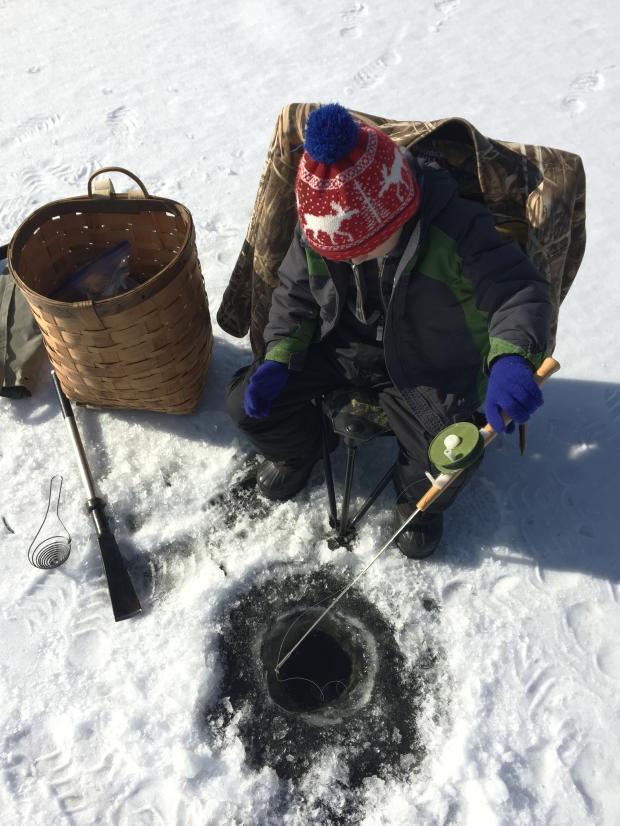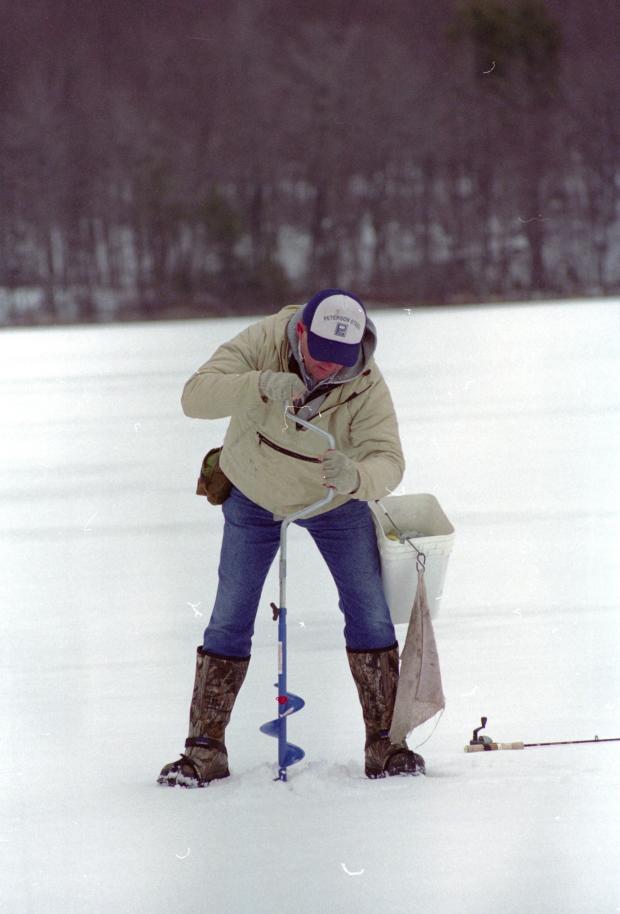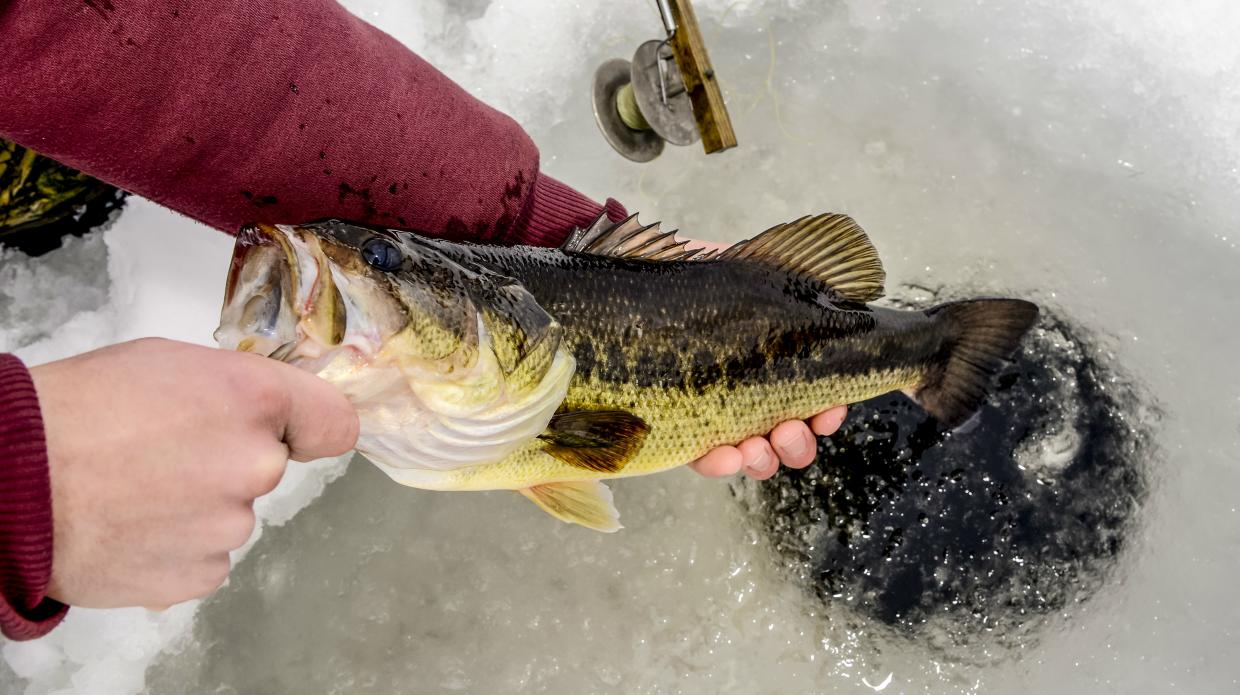Ice fishing safety
How can you tell if ice is safe?
Always consider ice to be potentially dangerous. You can't judge conditions by appearance or thickness alone. Many other factors impact ice strength like water depth, size of waterbody, water chemistry, currents, snow cover, age of ice, and local weather conditions
Ice tips
- New ice is stronger than old ice. Four inches of clear, newly formed ice may support one person on foot. One foot or more of old, partially thawed ice may not.
- Ice doesn't freeze uniformly. Continue to check ice conditions frequently as you venture out onto the ice.
- Avoid traveling onto ice-bound rivers and streams. Currents make ice thickness unpredictable. Many lakes and ponds contain spring holes and other areas of currents that can create deceptively dangerous thin spots.
Video: MassWildlife ice safety video
Skip this video MassWildlife ice safety video.Ice thickness guidelines
The guidelines below are for clear, blue ice on lakes and ponds. White ice or snow ice is only about half as strong as new clear ice and can be very treacherous. Use an ice chisel, auger, or cordless drill to make a hole in the ice and determine its thickness and condition. Bring a tape measure to check ice thickness at regular intervals.
| Ice Thickness (inches) | Permissible Load (on new clear/blue ice on lakes or ponds) |
| 2" or less | Stay off! |
| 4" | Ice fishing or other activities on foot |
| 5" | Snowmobile or ATV |
| 8"–12" | Car or small pickup truck |
| 12"–15" | Medium truck |
What to bring
Ice fishing can be simple or more elaborate and costly. Here are the essentials:
- Fishing license. You need a license if you are 15 or older. Licenses can be purchased online through MassFishHunt.
- Proper clothing. Dress in layers with a moisture-wicking base and a windproof, waterproof top. Middle layers can be anything warm that you can take off or put on throughout the day.
- Ice chisel or auger. These are used to drill a hole into the ice.
- Tip-ups and jig sticks. You can use either method or combine them. Each tip-up and each jig stick counts as a hook. Anglers are allowed up to 5 hooks through the ice at one time.
- Tip-ups, also called traps, types, or tilts, are easy to use with a little practice. The most basic tip-ups are three thin pieces of wood, a small metal spool to hold your line, a bit of spring steel with a flag attached to the end, and a trigger mechanism to allow the flag to pop up. Massachusetts allows five tip-ups per angler.
- Jig sticks look like standard rods and reels, only smaller— about two or three feet long. To keep it simple, grab a hand auger, jig stick and some bait and head to the ice.
- Baitfish and bait bucket or lures.
- Sounding weights or “sounders” to measure your depth when setting your tip-ups.
- Ice scoop to remove slush from holes after drilling and keep them clear. It’s also a handy tool for estimating ice thickness; use the backside of the scoop, inserting it down the hole until it hooks the bottom of the ice.
- Hook removal tool like a pair of needle-nosed pliers.
- Fingernail clippers for clipping line.
- Sled or pack basket to haul your gear. Some ice anglers make their own out of old sleds and toboggans.
- Cleats or spikes for the bottom of your boots if the ice is slick.
- Comfort items if you plan on being out for a while. Consider a folding chair, food, hot drinks, and hand or foot warmers.
Where to go
Visit the Go Fish MA! interactive map to find spots near you.
Use this map to view depth and find fish at different depths.
During winter, the deeper parts of a pond are the warmest, and these are typically where fish spend their time. As winter progresses, deeper areas become depleted of oxygen, and fish start to rise and move towards inlets, where there is more oxygen and food. If you’re fishing on one of the 168 Massachusetts ponds with digital bathymetry (depth) information, you can use your mobile device to access a pond map and see this information as you walk.
To get started:
- Open the Go Fish MA! interactive map
- Use the filter at the bottom center to narrow your search to show ponds with Digital Depth, then zoom in to see it
- If you’re at a pond, click the My Location button (circle or crosshair icon) to show your movements in real time
Ponds without digital bathymetry offer other valuable information. Pond map summaries offer details about access and fish populations, as well as bathymetric maps in PDF formats.
Remember safety: Avoid going onto ice-bound rivers and streams; currents make ice thickness unpredictable. Lakes and ponds may contain spring holes and other areas of currents that can create dangerous thin spots.
How to get through the ice
Hand augers have two blades that need to be sharpened regularly. Always replace the blade cover after drilling your holes, and never set the auger down carelessly.
- To start a hole, set the auger on the ice gently, plant your feet firmly, and begin drilling. You’ll be most effective with your dominant hand doing the turning and your non-dominant had on top of the auger.
- Once you break through the ice, push the auger down a bit, then back and forth (with the middle of the auger, not its blades) break the last little lip of ice before pulling it back up. Avoid pushing the blades into the bottom, if you are drilling in a shallow area.
Power augers cut holes fast, but they cost more. Choose from gas, propane, or electric battery powered models. For a less expensive option, consider a cordless drill-powered auger. This setup uses a powerful cordless drill (at least 18 volts with a 3 or 4 amp-hour battery pack) attached to a base plate mounted on top of a hand auger.
Chisels are best for thinner ice conditions of 6 inches or less. Keep the blade honed to a sharp edge. Attach a rope or strap to the top of the chisel and wrap it around your wrist while you are actively chiseling. Many a chisel has been lost by people forgetting this simple step.
Ice fishing methods
You can use tip-ups or jig sticks to catch fish through the ice.
Fishing with tip-ups
Tip-ups (also called traps, types, or tilts) are designed specifically for ice fishing. They are made to hold a spool of line and keep your bait at a desired depth. When a fish bites, a flag pops up to alert the nearby angler. Although individual tip-ups vary among manufacturers, the designs are all similar. Most people use live bait when fishing with tip-ups.
Setting your tip-ups
Video: MassWildlife ice fishing tip-up video
Skip this video MassWildlife ice fishing tip-up video.- Drill a hole and skim away ice chips and slush.
- Open the tip-up and pull up the flag (don’t set it yet).
- Attach the sounding weight to the hook and lower the line into the hole. When the weight touches bottom, slide the button/ice bobber to the water line. Now slide the button or bobber down about 1-2 feet towards the hook. The button now marks the depth where your bait will sit—it’s a few feet above the bottom of the pond and more visible to fish.
- Retrieve the sounding weight then bait the hook. Firmly hold the shiner and insert the hook behind the dorsal fin and just under the spine, to allow the shiner to swim naturally.
- Lower your baited hook (with a small weight attached above it) into the hole until the button is visible on the spool from above. (If you get a flag, and the button is gone, you likely have a fish on the hook. If the button is in place, and the flag is up, the wind probably tripped the flag.)
- Check your line to make sure it spools freely and trips the flag mechanism. Lower the spool into the hole. Set the flag by swinging it down and attaching it to the trip mechanism. Make sure to attach it on the correct side of the mechanism.
Massachusetts allows five tip-ups per angler
Catching fish with tip-ups
- Tending your tip-ups
- Check your bait often—fish can take bait without tripping the flag.
- Keep holes clear of ice when they freeze over. This can happen quickly on cold days.
- When you have a fish on the line
- Set the hook. Wait for the fish to stop swimming, then gently pull up the slack line and give a solid tug to set the hook. If you use circle hooks (recommended), the fish pretty much set the hook by themselves and typically do not swallow the hook.
- Reel it in. Keep the line tight and use a continuous hand-over-hand motion to pull the fish in. Neatly coil the line on the ice to prevent tangles if the fish starts swimming away and starts pulling line back into the water.
- Steady landing. Use a steady even motion to pull the fish up through the hole and out onto the ice. Jerking the fish may cause the hook to pull out or line to break. If you don’t plan to eat the fish, get it back into the water quickly. Unhook it and slide it headfirst through the hole.
Video: catching a fish with a tip-up
Skip this video catching a fish with a tip-up.Jig fishing ("jigging")
Jig sticks look like standard rods and reels, only smaller— about two to three feet long.
- Use bait or lures. Common jigging lures are bucktail jigs, spoons, and small artificial grubs. Live baits include minnows, fish eyes, small grubs (“spikes”), mealworms, and earthworms. A popular combination is a jigging lure tipped with a small grub or perch eye.
Tip: It is good to attach a strike indicator to the tip of your jig stick to alert you that you have a bite. The bite can be very subtle at times. - How to jig. Lower your lure or baited hook through the hole until it touched the bottom, then reel up a few feet. Lift and twitch the rod to create an erratic up and down motion. Small movements work; avoid a lot of motion.
Tip: If you don’t get a bite after about 5 to 10 minutes, move and drill another hole. Keep moving until you find fish. - Setting the hook. When a fish grabs the bait, use a quick upward snap of the wrist. Artificial lures fool the fish into biting, but they reject the lure almost immediately, so be quick to set the hook. Keep tension on the line until you bring the fish through the ice.
Tip: After you land the fish, get your line back in the water quickly, because often there will be other fish in the area.
General ice fishing tips
- Know where fish live. During winter, the deeper parts of a pond are warmest and typically where fish spend their time. As winter progresses, deeper areas become depleted of oxygen and fish start to rise and move towards inlets where there is more oxygen and food. Keep in mind that this ice may be thinner, so use caution.
Use the Go Fish MA! interactive map to find bathymetry (depth) for many ponds. Narrow your choice to show waterbodies with Digital Depth, then zoom in to reveal the bathymetry details. - Make some space. Drill your hole, scoop out the hole and move all the ice and slush far enough away from your hole that the line will not get caught on it when pulled out.
- Keep bait handy. Your bait bucket should always be at your side. When you have a flag, it usually means lost or damaged bait.
- Be patient. Check tip-ups at least once an hour. Make sure lines are free by chipping and skimming out ice from your holes. Make sure the bait is not fouled in weeds or structures and is alive and swimming. If things are slow, drill new holes and move your tip-ups around.
- Think small. Your chances of success will increase by offering a morsel rather than a meal. With smaller bait, you will attract small and large fish. If you only use large baits, you will likely only catch large fish—this sounds great, but it can make for a long day without much action.
- Try chumming. Clean your fish right on the ice, and put the entrails in one or more of your holes to attract fish.
- Use scent. If you’re using lures for jigging, add a grub or perch eye to the tip for extra attraction.
- Avoid drilling holes too close together. If holes are too close, a hooked fish can tangle a nearby tip-up line.
- Go easy. When you see the fish’s head at the hole, do not pull up abruptly, or you may pull out the hook or break the line. Gently slip the fish out onto the ice.
- Wind flags. Turn the tip-ups towards the wind so the wind keeps the flag on the trigger mechanism.
- Be prepared to catch a variety of fish. You can expect to catch the same kinds of fish while ice fishing that you would during warmer weather including pickerel, yellow and white perch, black crappie, small and largemouth bass, and other sunfish, as well as trout, pike, and tiger muskellunge in certain waters.
Ice fishing regulations
Ice fishing requires a freshwater fishing license for those 15 and older. Get yours at MassFishHunt. Anglers are allowed up to five hooks through the ice at one time. A hook is defined as an angling device attached to the line of a tip-up or jig stick that is designed to take one fish at a time. This includes plain hooks, treble hooks, spinners, spoons, bait harnesses, jigs, or plugs. The device in question is not restricted to a single hook—lures with multiple treble hooks count as one hook in the water. Hooks can be on any combination of tip-ups or jig sticks, but no more than five hooks total.
All anglers must be able to tend their own hooks (tip-ups or jig sticks). Adults may assist minors with cutting holes or removing hooks, but minors must be capable of tending their own tip-ups or jig sticks.
Using bait
You can buy bait or catch your own.
Licensed anglers can take bait for personal use by all lawful methods, including a rectangular net not exceeding 36 square feet of net area, or by a hoop or circular net not exceeding 6 feet in diameter or with a fish trap with openings not exceeding one inch. Nets designed to gill fish are prohibited.
Only the fish species listed below may be taken for personal use as bait, live or dead, by licensed anglers:
- banded killifish
- fallfish
- fathead minnow
- golden shiner
- mummichog
- pumpkinseed
- yellow perch
- white sucker
- rainbow smelt
(Smelt may be taken only by hook and line. Possession or use of smelt as bait in inland waters other than during the smelt season is prohibited.)


